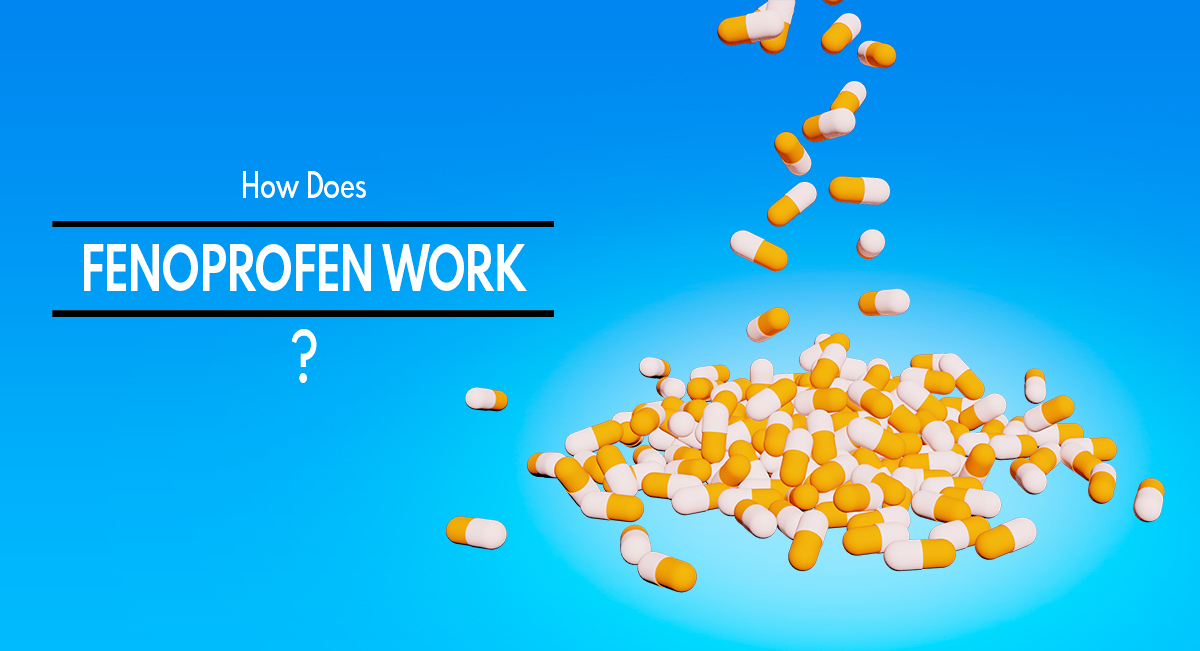Fenoprofen is classified as propionic group of NSAIDs. The drug was actively research for osteoarthritis. Fenoprofen is effective NSAIDs to treat joint pain but also needs close supervision. Fenoprofen increases bleeding by decreasing platelet function. Relative higher dosage can cause bleeding in subcutaneous tissue and brain resulting in bruises and stroke. Ibuprofen, ketoprofen, naproxen and Oxaprozin are the other NSAIDs included in subclass of NDAIDS propionic acid derivatives. Published data suggests therapeutic dosage of Fenoprofen has tried for 1 to 2 years in patient suffering with chronic arthritis. Long term therapy has not shown any gastric or intestinal side effects like ulcer and bleeding.
Alternative name of Fenoprofen
Also known as Alfon in USA and Fenopron in Europe.

How Does Fenoprofen Work?: Mechanism of Action of Fenoprofen
Fenoprofen decreases synthesis of prostaglandin and other chemicals produced in inflammatory tissue. Decrease prostaglandin enzyme causes decrease irritation of pain receptors and sensory nerve fibers resulting in less pain. Fenoprofen reducing secretion of prostaglandin by blocking the conversion of arachidonic acid to prostaglandin. Cyclooxygenase enzyme 1 (COX 1) and 2 (COX 2) initiates conversion of arachidonic acid to prostaglandin and Fenoprofen inhibits the action of cyclooxygenase enzyme.
Uses: Fenoprofen is Used for Treatment of Following Symptoms-
- Fever caused by infection and inflammatory diseases;
- Pain caused by inflammation and joint diseases;
- Pain following soft tissue and bone injuries;
- Tendinitis, ligamental inflammation or muscle inflammatory diseases;
- Tear or injury of muscle, tendon and ligaments.
Fenoprofen is Used To Treat Following Diseases
Osteoarthritis;
Rheumatoid arthritis;
Ankylosing spondylitis;
Juvenile arthritis;
Gout;
Tension headache;
Migraine.Dosage of Fenoprofen
Fenoprofen is sold as pills and capsules. The capsules and pills are available in concentration of 200 mg, 400 mg and 600 mg. The pills are prescribed 3 to 4 times a day. Daily dosage is adjusted to total dosage of 1600 to 3200 mg per day. Higher dosage between 1600 mg and 3200 mg is required for joint pain resistance to smaller dosage when pain is caused by rheumatoid or osteoarthritis. Lower dosages are used in patient suffering with liver and kidney diseases. Fenoprofen dosage of 1200 to 1800 mg is been recommended for long term treatment of chronic arthritis.
Duration of Action Fenoprofen
The peak level of Fenoprofen in blood is observed after 2 hours of taking pills or capsule. The optimum effect last 3 to 4 hours. Most of the Fenoprofen over 90% is eliminated in 24 hours, thus it is necessary the medication must be taken at regular interval to achieve consistent pain relief.
Side Effects Caused by Fenoprofen
Allergic reaction could be mild to severe. Severe reaction is rare but rarely can cause anaphylactic reaction. Watch for symptoms like sneezing, running nose, difficulties in breathing, wheezing, skin rash, hives, mucosal swelling of lips, tongue and breathing passage. Severe reaction may need emergency treatment call 911 and immediate attention by physician at clinic or ER.
- Skin rash;
- Fluid retention results in weight gain and peripheral edema mostly observe in extremities. The swollen finger and toe swelling suggests fluid retention.
- Abdominal pain caused by stomach and intestinal ulcer;
- Nausea and diarrhea;
- Coffee ground vomit because of bleeding in stomach mixed with food contents;
- Headache
- Dizziness and drowsiness;
- Tinnitus results in ringing in ear.
Precaution Needed in Following Condition
- Lower dosage is advised in patient suffering with moderate liver and kidney disease;
- Presence bruises;
- Lower dosage is required in patient who has coronary artery disease and may have undergone coronary artery bypass surgery;
Precautions needed when simultaneously antibiotics, antihypertensive medications, other NSAIDs, diuretics and anticoagulants are prescribed. Bioavailability of free medication is increased and thus lower dosage may be needed to prevent side effects of these medications.
Fenoprofen is Avoided in Patient Suffering With Following Disease
- Liver diseases
- Kidney failure
- Asthma
- Known allergies to other NSAIDs
- If rash or urticarial is observed following initial ingestion of medication
- Pregnancy particularly first and second trimester.
References
Longterm fenoprofen therapy in patients with rheumatoid arthritis.
J Rheumatol. 1976;2:43-8., Roth SH, Englund DW, Harris BK.
Treatment of rheumatoid arthritis with fenoprofen: comparison with aspirin.
Br Med J. 1974 Feb 2;1(5900):176-80.
Huskisson EC, Wojtulewski JA, Berry H, Scott J, Hart FD, Balme HW.
Fenoprofen in the treatment of osteoarthrosis.
Curr Med Res Opin. 1974;2(9):551-5., Wojtulewski JA.
